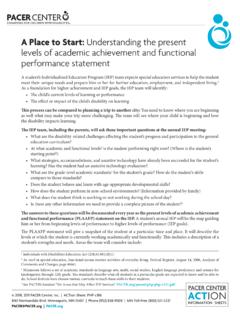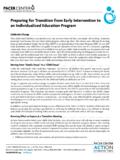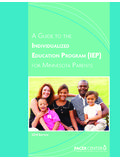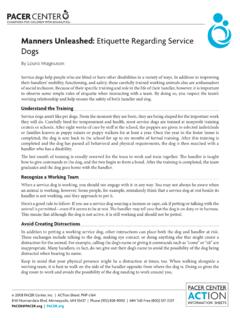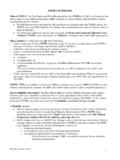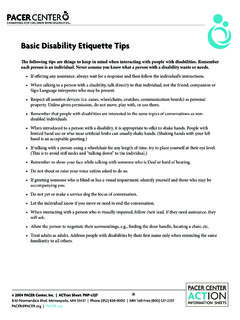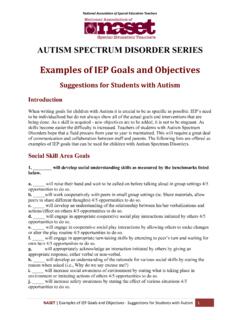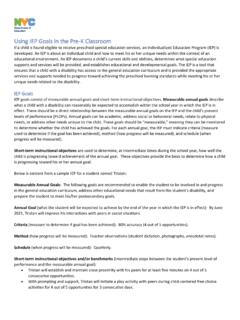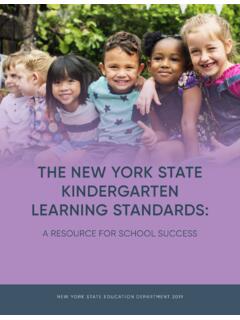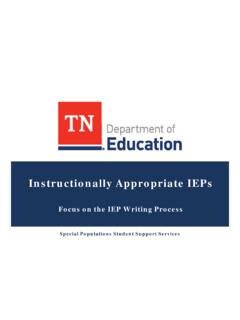Transcription of EARLY CHILDHOOD TRANSITION GUIDEBOOK - PACER
1 EARLY CHILDHOOD TRANSITION GUIDEBOOKWhat You Need to Know Before Your Child s Third BirthdayPACER Center | 8161 Normandale Boulevard | Minneapolis, MN 55437-1044 Voice (952) 838-9000 | Toll-free in Greater MN (800) 53- PACER Fax (952) 838-0199 | Goldberg, PACER Executive Director 2010 PACER Center. All rights reserved. No portion of this book may be reproduced, stored in a retrieval system, or transmitted in any form or by any means, electronic, mechanical, photocopying, recording, or otherwise, without express written permission of PACER Center. This publication was funded through a grant from the Minnesota Department of source of the funding is from federal awards, Special Education-Part CHILDHOOD TRANSITION GuidebookWhat You Need to Know Before Your Child s Third BirthdayTable of ContentsWhat TRANSITION Is ..2 When and How to Plan for TRANSITION ..2 Questions You May Want to Ask at a TRANSITION Meeting.
2 3 How to Determine Your Child s Evaluations Are Conducted ..4 Writing the IEP ..4 Preparing for the Meeting ..4 Writing goals ..5 Identifying What Services Will Be Provided, Where ..5 Determining When Services Will Be IEP or IIIP? ..5 Choosing a Preschool Program ..6 Child Care ..6 EARLY CHILDHOOD Setting ..6 Next Steps ..7 Preparing Your Team, Family, and Child for the Changes ..7 Parents Need to Know ..7 What to Do if Your Child Is Not Eligible for Preschool Special Education Services ..8 The Journey Continues ..8 Additional Resources ..8 TRANSITION Checklist ..9 Glossary ..10 TRANSITION Timeline ..112 EARLY CHILDHOOD TRANSITION GuidebookYour child s third birthday is an important day. Aside from being a time to celebrate, it also marks the TRANSITION from Help Me Grow Infant and Toddler Intervention services to a preschool option. This TRANSITION changes the services available to you and how they are provided, as the focus moves from your child with a disability or developmental delay and your family to just your child.
3 This GUIDEBOOK includes information on what TRANSITION is, how and when to plan for it, how to determine if your child is eligible for Help Me Grow Preschool Special Education services, how to implement the TRANSITION plan, and what to do if your child is not eligible for special education services. You ll find tips and facts that can help you plan for this important change in services before you light those three TRANSITION IsIn Minnesota, the Infant and Toddler Intervention program covers children ages birth to 3 years who are eligible under Part C of the Individuals with Disabilities Education Act (IDEA). Part C focuses on helping the family meet the developmental needs of their child, such as learning to sit up, walk, or talk. Typically provided in natural environments, such as the child s home or child-care setting, these services and outcomes for the child and family are defined in an Individualized Family Service Plan (IFSP).
4 From age 3 until a child enters kindergarten, Preschool Special Education serves children who are eligible under Part B, Section 619, of IDEA. The IFSP is replaced by an Individualized Education Program (IEP). The preschool IEP contains goals and objectives to address your child s unique needs as he or she learns the skills needed to prepare for kindergarten. As your child makes this TRANSITION , services and supports change. Members of the team who helped you develop the outcomes specified in the IFSP may be different from those who will help to develop your child s IEP. Instead of working with a service coordinator, you will work with an IEP case and How to Plan for TransitionAt least three months before your child s third birthday, your service coordinator will call one or more TRANSITION conferences to discuss your child s needs and preschool options. This conference could be combined with a regularly scheduled IFSP meeting.
5 You, your service coordinator, and other members of the IFSP team as appropriate will be included. Others may be invited as well. These people may include EARLY CHILDHOOD special education staff, representatives from community programs or services (such as a child-care provider, private preschool, or Head Start), and anyone else you would like to have there, such as grandparents, neighbors, or friends who know your child CHILDHOOD TRANSITION GuidebookTogether, you and the team will address a variety of topics, such as the need for an evaluation to determine eligibility; goals , timelines, and team members responsibilities; your hopes, dreams, and concerns about your child; services and programs available; and your special education legal rights. Based on those discussions, you ll develop a TRANSITION plan and prepare for the change in programs when your child turns 3. Questions You May Want to Ask at a TRANSITION Meeting What are the differences between EARLY intervention and preschool services?
6 How will our child s eligibility be determined? What are the different ways services can be provided? Whom do we contact if we want to visit a program or classroom? How can we help professionals understand the unique strengths and needs of our child? When will we meet next? How to Determine Your Child s Eligibility Not everyone who receives services through Infant and Toddler Intervention is eligible for Preschool Special Education services. To determine eligibility, your child will need to be evaluated. The evaluation will address the following questions: Does your child have a developmental delay or disability? What are your child s present levels of performance? Does your child s developmental delay or disability have an adverse effect on your child s ability to participate in and benefit from age-appropriate activities? Does your child need special education and related services?To answer these questions, an evaluation will look at relevant cognitive, behavioral, physical, developmental, and other factors.
7 The evaluation involves gathering information from many sources about your child s functioning and development in all areas of suspected developmental delay or disability. You play an important role by sharing helpful information such as medical reports or the results of private evaluations. You are also the expert on your child and know what your child has learned already. You know what your child likes and dislikes and how your child likes to play. All of this information can be used to determine your child s educational and developmental needs. The team, including you, will decide what assessments are needed to determine eligibility and plan for your child s education. Depending on your local school district, the professionals who have been providing services to your child and family may remain the same, or a whole new team of professionals may be involved in doing any needed evaluations and providing services if your child qualifies.
8 You will be given two documents before the evaluation takes place. One is a Prior Written Notice form, which includes all the actions the district proposes to take, including the areas to be assessed and the tests that will be used. The other is a Parent Consent/Objection form. The evaluation will begin after you sign this your child entered the Infant and Toddler Intervention program after the age of 2, the team may have done both Part C and Part B evaluations at that time. If your child qualified for Part B services then, it is not likely that further evaluation would be needed prior to writing the IEP. If your child was not eligible at that time, the team will review progress and determine if your child is potentially eligible. If so, an evaluation plan will be CHILDHOOD TRANSITION GuidebookHow Evaluations Are ConductedYour school district must have your informed, written consent to evaluate your child. Before you consent to the evaluation, you may wish to consider the following questions: What tests and other evaluation materials are being considered for my child and why?
9 How will the information be used to plan my child s education? Will my child s disability interfere with obtaining valid tests scores in any area? How will my child s native language and culture be taken into consideration during testing? What will be done to help my child feel comfortable during the testing session? What kind of information will I be asked to contribute to the evaluation?After you sign the consent form, your child s individualized evaluation will be conducted by a team of professionals at your home, child-care setting, school district, or other location. The purpose of the evaluation process is to help members of your child s IEP team paint a complete picture of your child. You may be asked to share information through an interview or as part of a questionnaire. The questions may be about your child s birth and medical history, developmental milestones and progress, and home and family environments.
10 PACER encourages you to ask questions about the process at any point. If there is anything you do not understand, talk to your service coordinator or call PACER Center. When the process is complete, you will be given a copy of the evaluation report and an explanation of how your child does or doesn t qualify for EARLY CHILDHOOD special education services. If your child is eligible for services and you agree to receive them, the team will meet to write an you disagree with the evalution results, you may have the right to obtain an independent educational evaluation (IEE) at school district expense. An IEE is conducted by qualified staff not employed by the school district. You can contact PACER Center for further the IEPWhen a child qualifies for Preschool Special Education and related services, the IEP team determines the appropriate services based on the results of your child s evaluation. That determination begins with one or more IEP meetings, which include the family, a special education teacher, administrative personnel, related service providers as appropriate, and others the family or school district may wish to invite.
